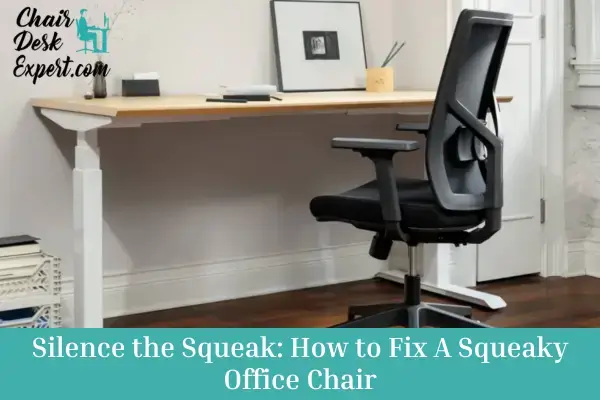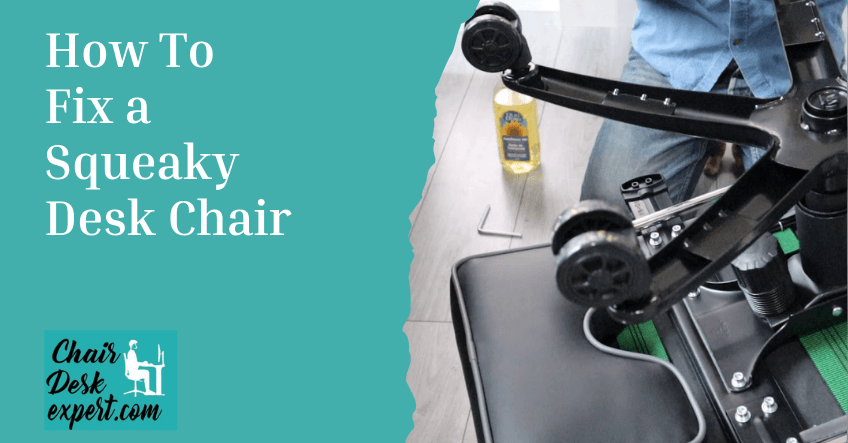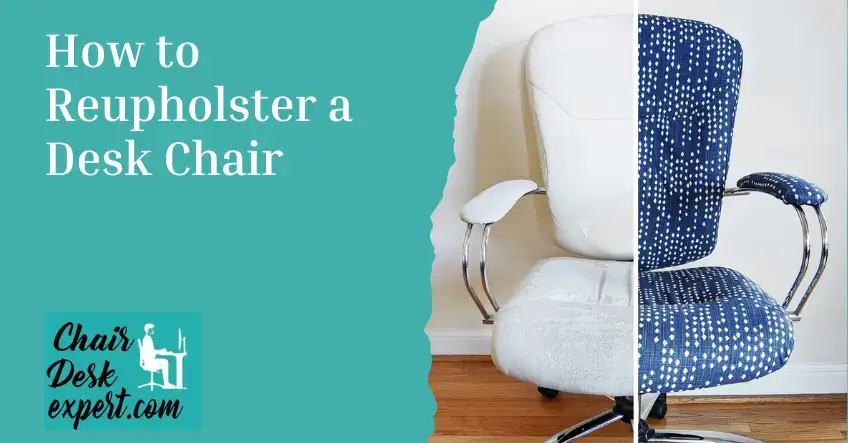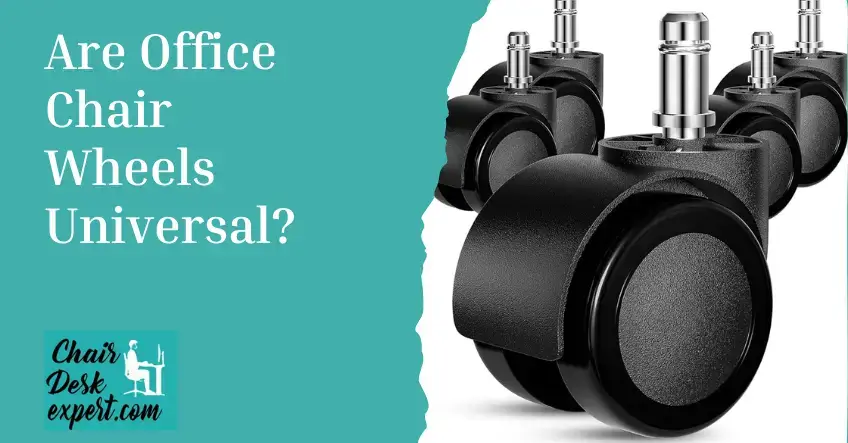Your home office setup is excellent, but that annoying squeak from your chair is driving you crazy. Whether it’s your computer chair, leather swivel chair, or gaming throne, that creak is a major distraction. Let’s find out why it’s happening and How to fix a squeaky desk chair.
Silence the Squeak: How to Fix A Squeaky Office Chair!

Eliminate distractions with our quick fix for your squeaky office chair. Discover simple solutions on How to Fix a Squeaky Office chair to silence the irritating noises and regain focus on your work.
Possible Causes for Your Squeaky Desk Chair. To resolve the issue of a noisy office chair, the root causes must first be identified.
>> Read Also: Should I Get a Desk Chair with Arms
1-Loose Parts:
Over time, some parts of the chair may become faulty as bolts and screws loosen. Even slight slackness in these joints results in squeaks that usually require simple tightening.
2-Shaky, Unstable Chair Legs:
Confirm that legs are screwed properly. Shaking or unstable legs cause squeaks as well as endangering life.
3-Old, Worn-Out Parts:
During use, some chair parts, such as the seat tension spring, may wear off or get stripped. Rusty elements are frequent causes of squeaks which would require immediate replacement. Watch out for rust on some parts because it leads to more noise from seats thus calling for its substitution.
4-Springs and Wheel Axles
It’s important not to ignore springs and wheel axles when identifying why your chair produces this irritating sound. While people often look at loose screws and bolts.
It is worth noting that springs can deteriorate over time while wheel axles could be damaged thus perpetuating the problem; hence check these components closely during the troubleshooting process.
>> Read Also: What Is The Ideal Height For A Desk Chair?
Quiet Comfort: Easy Solutions to Fix a Squeaky Desk Chair
Follow these easy solutions to silence the squeaky chair.
1-Lubricating Metal Parts
Lubricant your office chair to make it silent by following these steps.
Step-1 Examine nuts-and-bolts-and-screws:
Turn over the chair while inspecting all hardware. Tighten any loose nuts, bolts, or screws with a screwdriver or wrench if they need tightening even if they don’t seem loose to prevent chafing and squeaking sounds that may result from loose parts.
Step 2: Grease the mechanisms.
To free up joints, apply lubricating oil to all nuts, screws, and bolts. Spray oil directly onto the chair mechanisms; then wipe them dry.
Or spray oil on a soft cotton cloth and rub it on problem areas for precise applications. Regularly lubing metal parts prevents rust building caused by moisture in the air and air conditioners.
Step 3: Take out bolts and screws for greasing.
If even after tightening and lubricating, squeaking continues then remove all bolts and screws. Lubricate them with light machine oil before reinstalling them.
Step 4: Let a companion sit in as you apply oil.
Ask someone to sit down in the chair but swivel it from side to side to determine where the sound is coming from accurately.
Apply some more when it is being used right on top of any noise-originating spot. Repeat it until it doesn’t make a sound again.
Step 5: Are wheels moving smoothly?
Roll the chair back and forth to check the wheels. Sometimes, the wheel axle of a chair may require silicone spray on it so that it can continue to move smoothly.
Turn over and spray the wheels with silicone spray. Finally, flip it back and roll it over to distribute the silicone evenly across the wheels.
Step 6: Carefully sit down.
The reason for avoiding collapsing into the seat is because this results in loose joints thus causing eventual squeaking. Be careful while sitting down as this will reduce wearing away from the chair.
>> Read Also: How Tall Should a Desk Chair Be
Repairing Wooden Chairs
Step 1: Check for Loose Legs, Screws or Nails
Check if there are any leg screws or nails that are hanging loosely by holding them softly and moving them up and down slowly. Ensure minimal movement as much as possible.
Step 2: Flip Chair Upside Down
To easily access parts you wish to work on without putting pressure on your legs or back, place the chair upside down on a table or another chair.
Step 3: Apply Glue to Loosened Joints
Put some wood glue to hold loosely joined leg joints together, and allow time for drying before placing right-side-up again; wipe off extra wet material using a damp cloth.
Step 4: Expanding Dowels Using Wood Swelling Liquids
For very loose legs, remove their dowels and apply wood swelling liquid so that when they dry out they can be put back into position securely again.
Step 5: Replace Nails or Joint Plugs
A good idea would be to replace any loose parts with new ones. Put more nails if need be or bracket hinges on your chair. Use screws that are long enough but do not bend inside the wood after they have penetrated through from one end.
READ MORE:>>> best office chair under #200
Squeaky Chair Prevention
Preventing your chair from squeaking involves far more than just lubricating its components. Weight capacity and ergonomic design are important considerations in providing both comfort and durability.
Choose ergonomic chairs with higher weight capacities such as the Ergonomic Chair that can support up to 275 pounds for long work days. On the other hand, the Daily Chair, which can handle a weight of 225 pounds, is comfortable during short periods of work.
These chairs come with a seven-year warranty and are made from designs crafted out of seventy percent recycled materials and breathable mesh that increases comfort.
Bear in mind that using an office chair that is not ergonomically suited to your body or sitting for long can also result in poor posture and spinal discomfort.
By assessing your office furniture, you create a conducive environment where you will have your long-term health and comfort preserved.
Final Verdict
Now you will be well aware of How to fix a squeaky desk chair. In a workplace full of many distractions, you definitely do not want your chair squeaking incessantly.
Whether you are sitting at home in isolation working remotely, negotiating hybrid work arrangements or working at an office location where there may be others around; it can be quite irritating when the sound of a squeaky chair distracts you from concentrating on an important task or activity at hand.
It’s essential to evaluate how much time is spent in your office. After all, this is where the majority of individuals spend most of their day. Luckily there are many solutions available. Then why suffer anymore?
FAQs!
1-Why do office chairs squeak so much?
Loose screws and bolts are often the culprit. These parts can loosen over time due to inadequate assembly or temperature changes.
2-Why is my chair screeching?
Ensure all nuts, bolts, and screws are tightened using a screwdriver. Use lubricating oil like WD40 to grease up the screws and bolts to prevent stiffness and noise.
3-Why does my chair squeak when I lean?
The squeak when leaning back may be caused by the seat tension spring. Apply lubrication to this spring after removing the seat tension turn knob.
4-Can you fix a squeaky gaming chair?
Yes, you can fix it. Tighten any loose screws, bolts, or nuts. Apply lubricant to moving parts such as the swivel, gas lift, or tilt mechanism.
5-Is WD-40 a lubricant?
Yes, it is. While WD-40 stands for Water Displacement, it is also a lubricant composed of a unique blend of oils, anti-corrosion agents, and ingredients for penetration, water displacement, and soil removal.









